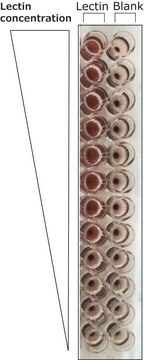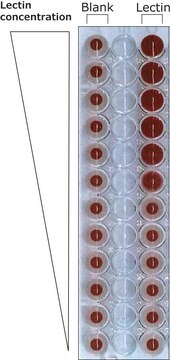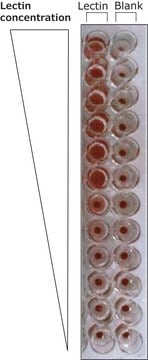L5391
Lectin from Bandeiraea simplicifolia (Griffonia simplicifolia)
Isolectin B4 (BSI-B4), peroxidase conjugate, lyophilized powder
Sinonimo/i:
Bandeirea simplicifolia agglutinin, BS-I
About This Item
Prodotti consigliati
Origine biologica
Bandieraea simplicifolia
Livello qualitativo
Coniugato
peroxidase conjugate
Saggio
≥90% protein basis (Warburg-Christian)
Forma fisica
lyophilized powder
Potenza
<200 μg per mL agglutination activity (using human blood group B erythrocytes)
peroxidase activity
40-160 units/mg protein
Composizione
Protein, ~95% modified Warburg-Christian
tecniche
blood typing: suitable
fractionation: suitable
Temperatura di conservazione
−20°C
Cerchi prodotti simili? Visita Guida al confronto tra prodotti
Applicazioni
- Glycoprotein sample size: 500ng
- Lectin Concentration: 0.1ug/ml
- Load samples at 500 ng of glycoprotein per lane
- Run 4-20% Bis-Tris SDS page gel
- Transfer gel to a PVDF membrane
- Block membrane for 1 hr at RT with RIPA buffer (R0278 Sigma)
- Incubate HRP lectin at 0.1ug/ml with RIPA buffer for 2 hours at RT
- Wash membrane 5 x 5 minutes with 25ml RIPA buffer
- Detect using chemiluminescent substrate (CPS1-120)
Azioni biochim/fisiol
Altre note
Definizione di unità
Stato fisico
Nota sulla preparazione
Risultati analitici
Codice della classe di stoccaggio
11 - Combustible Solids
Classe di pericolosità dell'acqua (WGK)
WGK 3
Punto d’infiammabilità (°F)
Not applicable
Punto d’infiammabilità (°C)
Not applicable
Dispositivi di protezione individuale
Eyeshields, Gloves, type N95 (US)
Certificati d'analisi (COA)
Cerca il Certificati d'analisi (COA) digitando il numero di lotto/batch corrispondente. I numeri di lotto o di batch sono stampati sull'etichetta dei prodotti dopo la parola ‘Lotto’ o ‘Batch’.
Possiedi già questo prodotto?
I documenti relativi ai prodotti acquistati recentemente sono disponibili nell’Archivio dei documenti.
I clienti hanno visto anche
Il team dei nostri ricercatori vanta grande esperienza in tutte le aree della ricerca quali Life Science, scienza dei materiali, sintesi chimica, cromatografia, discipline analitiche, ecc..
Contatta l'Assistenza Tecnica.











